Featured Photo: A male Black-throated Blue Warbler forages in sapsucker wells in a Sequoia tree near Sutherlin, Douglas County, Oregon, January 1, 2023.
Two years ago, I shared observations of diverse wildlife utilizing sap wells made by sapsuckers, specifically Red-breasted Sapsuckers in our area. I titled it “Sap on Tap Tap Tap,” and you can click on that title to read the post. I did not know at the time that only a month after publishing that blog post, I would find a beautiful male Black-throated Blue Warbler utilizing sapsucker wells near Sutherlin, Oregon. This lovely bird stayed in the area utilizing the sap wells for four months. While periodically checking on the warbler, I observed a number of other species using the sap wells. In this post I share the story of this warbler and other sap-sippers observed at this singular bank of sap wells.
On December 17, 2022, I was participating in the Roseburg-Sutherlin Christmas Bird Count (CBC). I had asked a friend for permission to count birds on their property near Sutherlin, Douglas County, Oregon. They graciously let me do so and I wandered down to an interesting patch of Giant Sequoia (Sequoiadendron giganteum). Apparently the area once hosted a variety of conifer species which someone had planted to produce Christmas trees. Still present in the grove were pines, true fir (Abies sp.), and Douglas-fir. They were eventually abandoned and grew over the following decades to the size they were now, some Sequoias nearly 100 ft tall. These were small as Sequoias go, the largest being not quite 4 feet in diameter. But they were evergreen, so they provided some degree of cover year-round.

I reached the grove of Sequoias and began making various noises, mainly owl and chickadee imitations, in an attempt to encourage any nearby birds to reveal themselves with a responsive call note or some movement. A small flutter near the middle of the canopy of a nearby Sequoia caught my attention. A very small bird was staying near the trunk of the tree, but fluttered down branch by branch to investigate the source of the sounds (me). I got my bins (short for binoculars) on the bird. Whoa! A male Black-throated Blue Warbler! And I began taking photos.

Black-throated Blue Warblers are rare but regular vagrants in Oregon, typically in spring and fall, with only a handful of winter records. They normally breed and migrate in eastern North America and winter on Carribean islands and nearby Middle America. This bird was a long way from its normal and typically warm winter range. It was cold here. The warbler made a very soft chip note, not unlike an Anna’s Hummingbird or Dark-eyed Junco, but perhaps even more faint. I continued taking photos, which proved to be a challenge among the vegetation and with low light.



I soon stopped making any attraction noises and the bird began to make its way back up into the canopy of this Sequoia, one of the largest in the grove. Eventually, at about 60 feet up in the tree, I saw them: sapsucker wells, hundreds of them. And they were fresh. The outer grayish brown bark of the Sequoia had been flaked off (by the sapsucker or a squirrel) revealing the fresh orange bark underneath. I hypothesized immediately that it was these wells that had led this bird to remain here. At what point the warbler first found this source of nutrition and energy I can only guess, but I would not be surprised if it was a month or two before this sighting.

I saw the warbler perch or hang on the bark of the tree, put its bill into one of the sap wells. With its bill in the hole for about a second or two, I presumed it was licking up some liquid, versus obtaining on insect, which I would expect to be more of a pecking or jabbing motion. The warbler appeared to obtain sap several times in the same hole, each time fluttering out to a branch, then back in, or to hang on the side of the tree, then back to the hole again. After foraging in this manner for 5-20 minutes, it finally disappeared like a ghost somewhere into the surroundings. I had more counting to do for the CBC, so I left the area.
Later that day I told the landowner what I had found and asked if I could brings some others over to look for the bird. Two days later I took a couple birding friends to the site, walked up to the tree, and there it was. The Black-throated Blue Warbler was back at the sapsucker wells.


Over the course of four months and 15 separate visits I brought a total of 75 people into this private property to see the Black-throated Blue Warbler. I also visited the site several times alone. The warbler typically could be seen within minutes, often within seconds, over the four months it remained here. Most days the warbler would be seen accessing the sapsucker wells with its bill.









On warmer days, some sort of insect (they looked like a typical housefly through my spotting scope) could be seen swarming near the patch of sap wells, and the warbler was observed to chase and snatch up these small insects near the wells. Over the course of its four-month stay, there were many freezing nights and multiple days with several inches of snow. The affinity of the bird to the group of sap wells on this tree suggests it was highly dependent upon the energy and nutrition for its survival in this decidedly non-Caribbean climate.



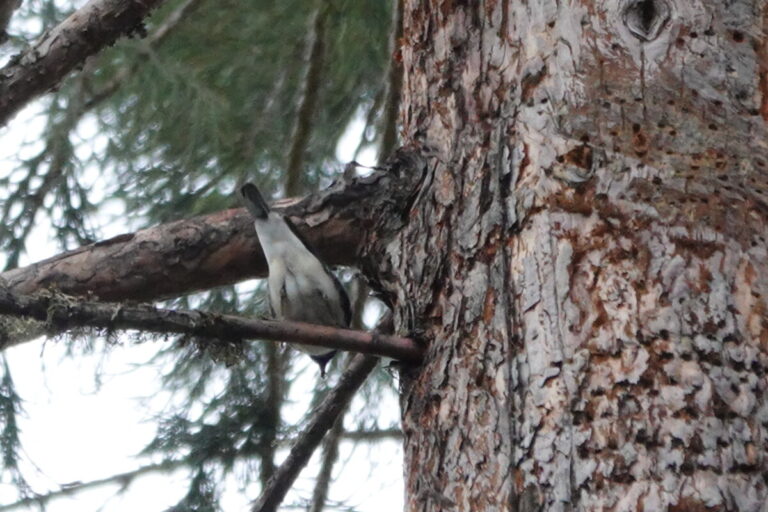
Over the course of the four months the warbler was present, several other species were seen utilizing the sap wells. But first, let me introduce the proprietor of this cambial fluid supply, the Red-breasted Sapsucker. Most of the winter only one sapsucker was observed at a time, but on occasion a second one was present as well.

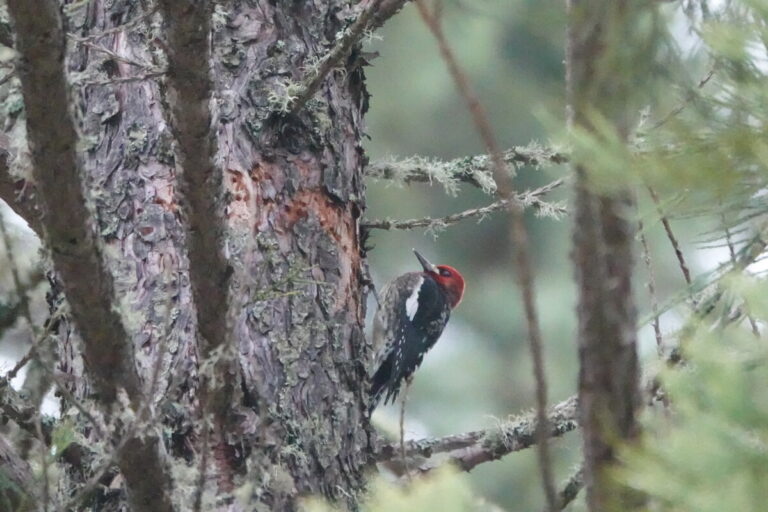

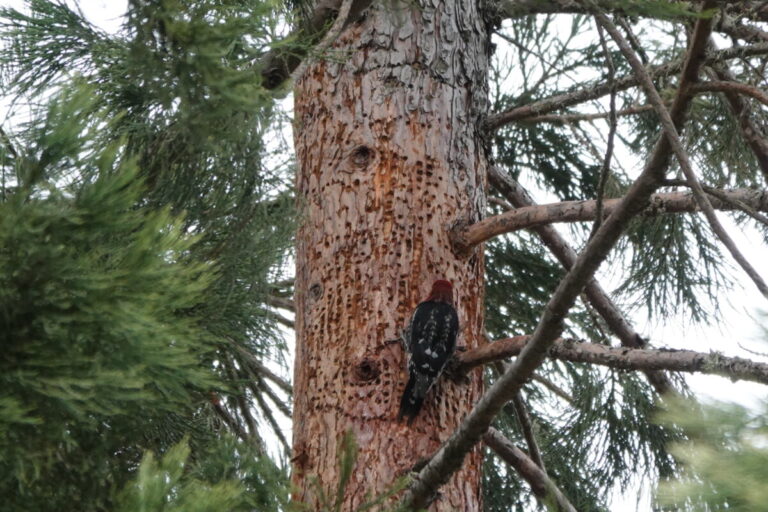
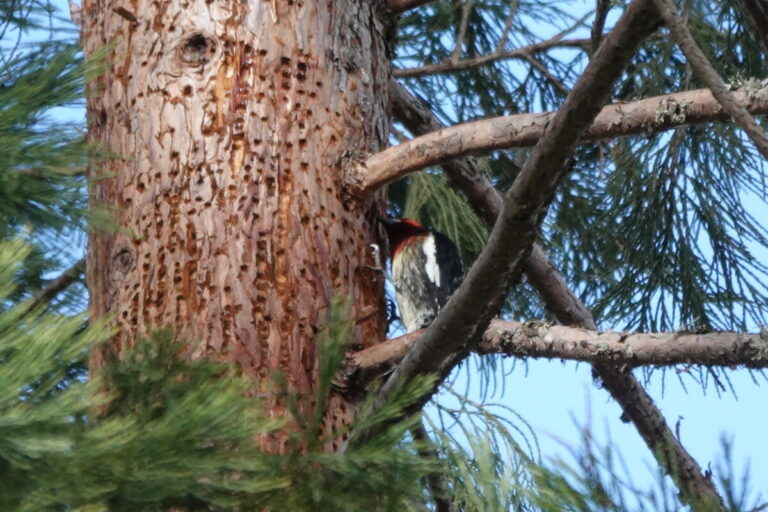

The sapsucker was present at the wells favored by the Black-throated Blue Warbler roughly half to three-quarters of the times we observed the warbler. Other times it was working on new holes in a nearby tree or not observed at all. It was interesting to see the sapsucker occasionally make brief aggressive shifts on the bark that would startle the warbler, which would fly out to briefly perch on a nearby branch, or utilize sap wells around the side of the trunk out of sight of the sapsucker. Following are a few photos of the sapsucker and warbler in the same photo.



No other species was observed at the sap wells on such a regular basis like the Black-throated Blue Warbler and Red-breasted Sapsucker. Nevertheless, four other species of birds and one mammal were observed utilizing the sap wells: Anna’s Hummingbird, Ruby-crowned Kinglet, Townsend’s Warbler, Steller’s Jay, and Western Gray Squirrel. After the warbler, the most common sap-sipper observed five or more times was the Anna’s Hummingbird. Both males and females were observed.






The next most common bird observed four or five times at the sap wells was Ruby-crowned Kinglet.







Townsend’s Warblers were heard or seen in the canopy several times, but I observed the species at the wells only once or twice.




Lastly, with regard to birds, this Steller’s Jay was observed to at least inspect and probe the sap wells. I don’t know if it imbibed any sap. Northern Flickers were occasionally in the canopy near the sap wells. They were not observed to investigate the sap wells, but I would not be surprised if they did so.

The only mammal observed to attend and feed from the sap wells was Western Gray Squirrel. I observed them four or five times at the wells, sometimes with up to three squirrels; usually only one feeding at a time. It appeared they simply inserted their tongue in the well to extract sap. Western Gray Squirrels have very powerful jaws and teeth that can chew through walnut shells and they are known to strip bark from smaller branches. They could easily have chewed through the bark and exposed the entire area. Nevertheless, perhaps they know that if they did so, the supply of sap may dry up and extensive damage to the tree may kill it eliminating the source altogether. I also wondered if the activity of the squirrels contributed to the removal of the outer dry flaky gray bark around the active sap wells.




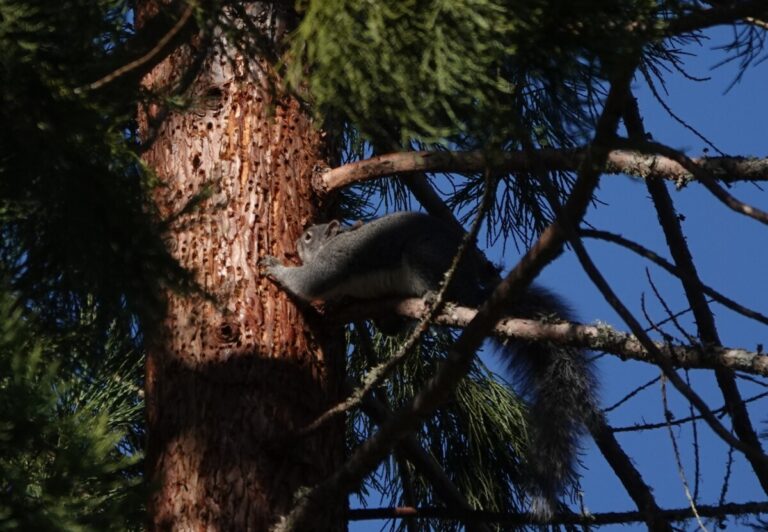
Determining what wildlife–vertebrates and invertebrates–are utilizing sap wells requires patience and repeated visits. It is likely that other species would be observed and a better assessment of use would be obtained with more time spent watching the wells. It would be interesting to know what species, if any, utilize the sap wells at night? Rats? Bats? Moths? I considered setting up a trail cam or two at this site, but the height…at 50-60 ft in the canopy…was a bit more than I wanted to risk. Perhaps YOU will find an active bank of sap wells closer to the ground and can monitor it yourself or with a trail camera! Let me know what you find out!

As spring approached, wild cherries and plums started blooming, and insect hatches became more common, the Black-throated Blue Warbler became less reliable at the sap wells. During the last several visits in April, the warbler was mostly observed in nearby deciduous shrubs and small trees with bursting leaf and flower buds, only visiting the sap wells briefly or not at all. During the last two or three visits it was heard to sing several times.







By mid-April, migrant Orange-crowned Warblers, Ruby-crowned Kinglets, and Lincoln’s Sparrows were singing, and the Black-throated Blue Warbler sang occasionally as well. The last day I observed the warbler was April 15, 2023, and I’ll leave you with my last photograph of the warbler; uncropped, unedited, and uncaptioned. Safe travels my friend….
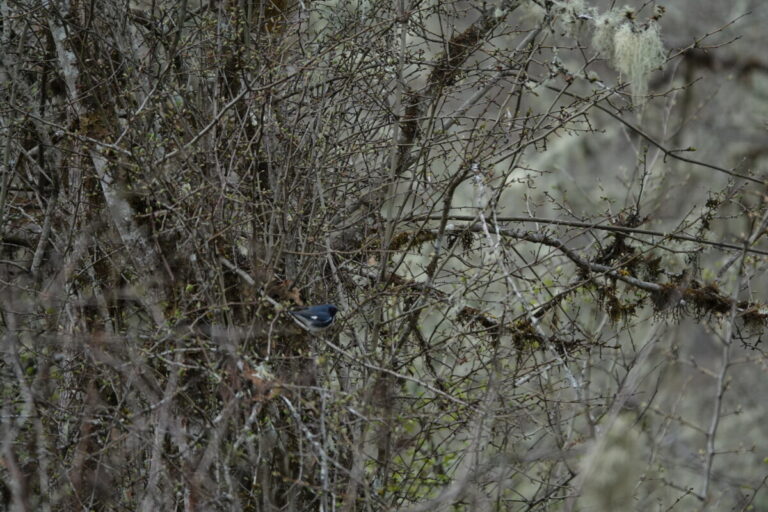
Have you observed various birds, animals, or insects using sapsucker wells? What species? What time of year? Where? Other details? Let me know in the comments.

This Post Has 7 Comments
Wow Matt, great writing and photography. I’ll be sure to watch the sap wells in my yard for interesting visitors. Barb Bresson
Hello Matt,
Thanks for this interesting post and the beautiful photos.
Last year I found a Cottonwood tree with sapsucker wells in the Children’s Arboretum in north Portland, Oregon. There was a feeding flock present. I remember seeing an Orange-crowned Warbler, a Black-capped Chickadee, an Anna’s Hummingbird and a Ruby-crowned Kinglet taking sips. The Ruby-crowned Kinglet was quite aggressive towards the other birds.
Great stuff Matt.
Minor correction– Sequoia sempervirens is the coast redwood rather than the giant sequoia, which is Sequoiadendron giganteum. Giant sequoias are the ones that grow above 4500 ft in the Sierras, mainly the southern Sierras. From the pictures (and the location) I’m pretty sure you were looking at coast redwoods.
Oops. Thanks Dave. My mistake. Yes, these are actually Giant Sequoias (or some very similar ornamental), versus redwoods. They have the long scales versus feathery needles on either side of the twig. I updated the scientific name (I had the scientific name of redwood in there).
Having lived in Virginia for several decades, I learned that if you find a Yellow-bellied Sapsucker in the winter, you are also likely to spot Yellow-rumped Warblers following the sapsucker and sipping from the wells. We routinely observed this on Sugar Maples, in particular.
We live at the Dallas Retirement Village and monitor two Weeping Cypress ornamental trees on our campus. Both trees are peppered with wells formed by Red Breasted Sapsuckers. They are very faithful “sippers” and we have observed them between September and April. While they are active and the sap is dripping Anna’s male and female zip in for a quick snack. Jeanette and Jim Scott